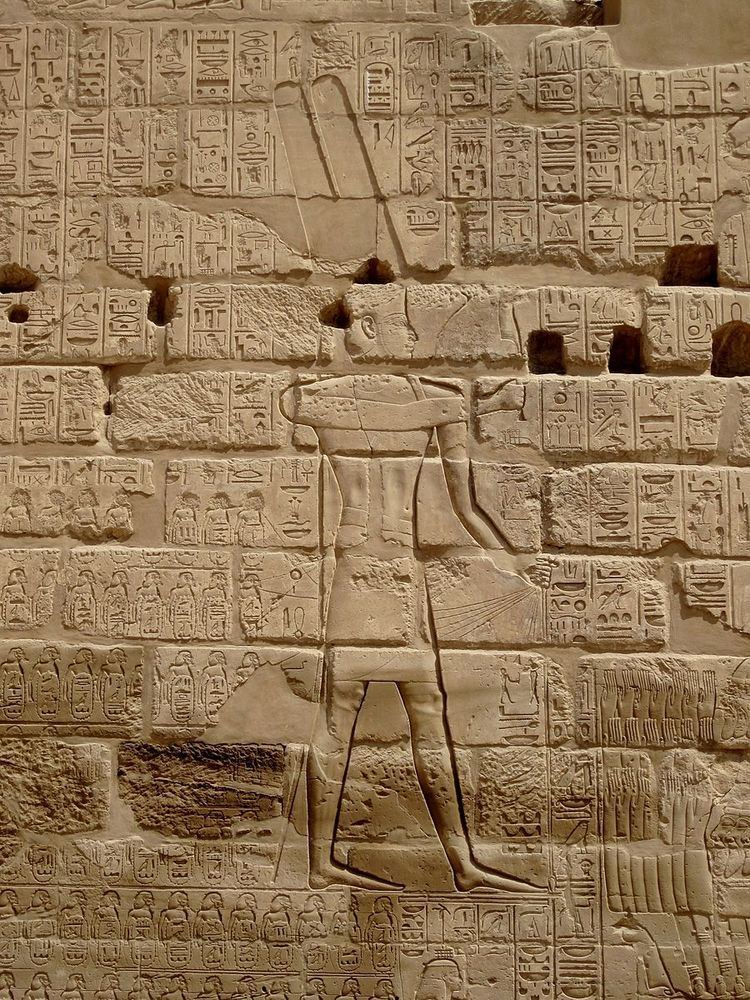 | ||
This Bubastite Portal gate is located in Karnak, within the Precinct of Amun-Re temple complex, between the temple of Ramesses III and the second pylon. It records the conquests and military campaigns in c.925 BCE of Shoshenq I, of the Twenty-second Dynasty. Shoshenq has been identified with the biblical Shishaq, such that the relief is also known as the Shishak Inscription or Shishaq Relief.
Contents
History
This gate was erected by the kings of the Twenty-second Dynasty of Egypt, also known as the "Bubastite Dynasty". It is located to the south-east side of the Temple of Ramesses III.
Although Karnak had been known to Europeans since the end of the Middle Ages, the possible significance of the Bubastite Portal was not apparent prior to the decipherment of hieroglyphics. Jean-François Champollion visited Karnak in 1828, six years after his publication of the Rosetta Stone translation. In his letters he wrote:
In this wonderful palace, I observed the portraits of most of the old Pharaohs known for their great deeds.... we see people fighting enemies Mandoueï of Egypt, and returning in triumph to his homeland, farther campaigns Ramses-Sesostris also Sésonchis dragging the foot of the Theban Triad (Amun, Mut and Khonsu) defeating thirty conquered nations, among which I found, as it should be, in full, Ioudahamalek, the kingdom of Judah, or the Jews. This matches the commentary in 1 Kings 14, which recounts the successful arrival of Sésonchis at Jerusalem: the identity that we have established between the Egyptian Sheschonck the Sésonchis of Manetho and Scheschôk or Shishak of the Bible, is confirmed in the most satisfactory manner.
Description
One facade shows King Sheshonq I, Teklot and Osorkon of the 22nd dynasty, making offerings to the gods and goddesses. Another scene shows Sheshonq grasping a group of captives by the hair and smiting them by his mace. Behind and below him, there are the names of Canaanite towns in several rows. Many of these are lost, but originally there were 156 names and one of the most interesting names which were mentioned is 'The Field of Abram' . The inscriptions give no details for this expedition and mentioned only the victory over the Asiatics.
Transliterations and translations
Below is a translation of the 156 names on the inscription.
Biblical narrative
The Biblical narrative recounts:
In the fifth year of King Rehoboam, because they had been unfaithful to the LORD, Shishaq king of Egypt came up against Jerusalem with 1,200 chariots and 60,000 horsemen. And the people were without number who came with him from Egypt— Libyans, Sukkiim, and Ethiopians. And he took the fortified cities of Judah and came as far as Jerusalem. Then Shemaiah the prophet came to Rehoboam and to the princes of Judah, who had gathered at Jerusalem because of Shishak, and said to them, "Thus says the LORD, 'You abandoned me, so I have abandoned you to the hand of Shishaq.'" Then the princes of Israel and the king humbled themselves and said, "The LORD is righteous." When the LORD saw that they humbled themselves, the word of the LORD came to Shemaiah: "They have humbled themselves. I will not destroy them, but I will grant them some deliverance, and my wrath shall not be poured out on Jerusalem by the hand of Shishaq. Nevertheless, they shall be servants to him, that they may know my service and the service of the kingdoms of the countries."
So Shishaq king of Egypt came up against Jerusalem. He took away the treasures of the house of the LORD and the treasures of the king’s house. He took away everything. He also took away the shields of gold that Solomon had made, and King Rehoboam made in their place shields of bronze and committed them to the hands of the officers of the guard, who kept the door of the king’s house. And as often as the king went into the house of the LORD, the guard came and carried them and brought them back to the guardroom. And when he humbled himself the wrath of the LORD turned from him, so as not to make a complete destruction. Moreover, conditions were good in Judah.
The account of Shishak carrying off treasures from Jerusalem is of dubious historicity; see Shishak § Biblical narrative.
